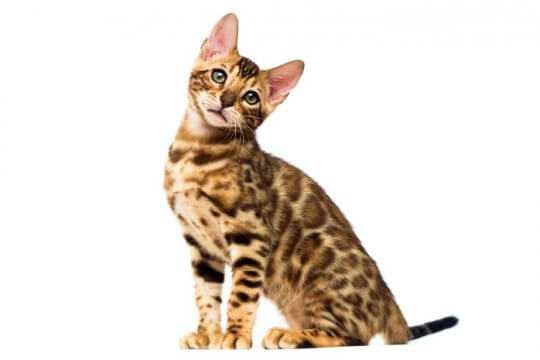Bengal

Origin
United States
Height
13"-16"
Adult Weight
6-15 pounds
Life Span
12-20 years
TEMPERAMENT
Energetic, curious, affectionate, intelligent
OTHER NAMES
Leopardette
Group
Large shorthair
Price
$1,500 - $3,000
Personality and Temperament
Care
- NUTRITION
- GROOMING
- EXERCISE
- HEALTH
Characteristics
History
The Breed Standard
Body
Bengal cats are medium to large in size, with sleek, muscular bodies. The hindquarters are slightly higher than the shoulders.
Head
The head is broad, with a modified wedge shape. Rounded contours and high cheekbones are preferable. The head is somewhat small in proportion to the cat's body. Mature males may display jowls.
Eyes
The eyes have a round to oval shape. They are large and set wide apart. Lynx-point Bengal cats must have blue eyes; cats of other coat colors may have eyes of any color.
Ears
A Bengal cat's ears are medium to small size with wide bases and rounded tips. They are set far apart, and follow the contours of the face when viewed from the front. When viewed in profile, the ears display a slight forward tilt. While tufting is undesirable, light, horizontal furnishings are acceptable.
Legs & Paws
The legs are of medium long length with substantial musculature. Rear legs are slightly longer than front legs. The paws are large and ground, and the knuckles appear prominent.
Tail
The Bengal cat has a medium-length tail that is proportionate to the body. The tail is thick with a tapered end and a rounded tip.
Coat
The Bengal cat has a short, soft, silky coat that lies close to the body. Glittering at the tips of the hair is desirable. Bengals may also have long hair. Long-haired Bengals are shown separately from short-haired Bengals.
Color
Bengal cats come in a variety of colors and patterns. Rosettes and spots may be displayed on the rosetted/tabby pattern. The marble pattern does not resemble classic tabby, meaning there is no circular pattern or bull's-eye. Rosettes and spots can be present on the marble tabby. The Bengal cat may be brown tabby, black silver tabby, blue tabby, blue lynx point, blue silver tabby, charcoal tabby, and all other tabby colors. Smoke pattern colors and melanistic pattern colors are desirable. Nose leather and paw pad color corresponds to coat color.
Frequently Asked Questions
-
How much do Bengal cats cost?
How much do Bengal cats cost?A pet-quality Bengal kitten usually costs anywhere from $1,500 to $3,000. Show-quality kittens might cost as much as $5,000. -
Why are Bengal cats so expensive?
Why are Bengal cats so expensive?Bengal cats are more expensive than non-pedigreed cats because reputable breeders spend a lot of time and money on their breeding programs to ensure their adult breeding Bengal cats are healthy, temperamentally sound, and good representations of the breed, so these qualities might be passed on to future generations of kittens. -
Are Bengal cats good pets?
Are Bengal cats good pets?Bengal cats are wonderful, engaging pets. They are friendly and affectionate, bonding closely with their human family. This breed is extremely active, so you must be prepared to provide enough exercise, play, and mental stimulation. -
Are Bengal cats cuddly?
Are Bengal cats cuddly?All Bengal cats are individuals, and some might enjoy cuddling more than others. Although friendly and affectionate, Bengals are so active that cuddles might be short-lived.